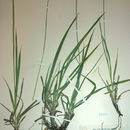Comprehensive Description
(
Inglês
)
fornecido por North American Flora
Carex raynoldsii Dewey, Am. Jour. Sci. II. 32: 39. 1861
Carex Lyallii Boott, 111. Carex 150. pi. 483. 1867. (Type from east side of Cascade Mts.).
Loosely cespitose, the rootstocks stout, scaly, creeping, the culms stout, erect, stiff, 2-7.5 dm. high, rather sharply angled, usually exceeding the leaves, smooth or nearly so, phyllopodic, purplish-red-tinged at base, the dried-up leaves of the previous year conspicuous; leaves with well-developed blades usually 5-10 to a fertile culm, clustered towards the base, the blades light-green, stiff, erect or ascending, flat with revolute margins, 5-20 cm. long, 3-8 mm. wide, attenuate, roughened towards the apex, the sheaths yellowish-tinged ventrally, concave at mouth, the ligule wider than long; terminal spike staminate, sessile or nearly so, linear, 1-2 cm. long, 3-4.5 mm. wide, the scales oblong-obovate, firm, obtuse or acutish, purplish-brown with lighter center and narrow hyaline margins; pistillate spikes 2-4, approximate or the lowest slightly separate, erect, the upper sessile or nearly so, the others more or less strongly peduncled, the peduncles nearly smooth, slender, stiff, the spikes oblong, 1-2 cm. long, 6-8 mm. wide, densely flowered, containing 15-40 ascending-spreading perigynia in several to many rows; bracts sheathless, dark-auricled, the lowest leaflet-like, about the length of the culm, the others much reduced ; scales broadly ovate, dark-purplish-black with lighter-colored, often nearly obsolete midrib and very narrow hyaline margins, short-acute or cuspidate, about as wide below as but considerably exceeded by the perigynia; perigynia oblong-oval or oblong-obovoid, somewhat inflated, suborbicular in cross-section, 3.5-4.5 mm. long, 1.75-2 mm. wide, glabrous, puncticulate, subcoriaceous, 2-ribbed and strongly several-nerved, yellowish-green, becoming yellowish-brown, substipitate, round-tapering at base, rounded and abruptly contracted at apex into a minute, purple-tinged, entire or emarginate beak 0.5 mm. long; achenes obovoid, 2.25-2.5 mm. long; 1.5-1.75 mm. wide, nearly as wide as but shorter than perigynia, triangular with thick angles and sides concave below, substipitate, yellowish-brown, minutely granular, apiculate, jointed with the straight, slender, slightly exserted style; stigmas 3, slender, short.
Type locality: "Pierre's Hole, valley of Snake River, June 20, 1860, 6000 ft. altitude, and Henry's Fork, June 22, 1860, 5500 ft. altitude. Dr. F. V. Hayden."
Distribution: Mountain meadows, Alberta to British Columbia and southward to Colorado, Utah, and middle California. (Specimens examined from Alberta, Montana, Idaho, Wyoming, Colorado, Utah. California, Oregon, Washington, British Columbia.)
- citação bibliográfica
- Kenneth Kent Mackenzie. 1935. (POALES); CYPERACEAE; CARICEAE. North American flora. vol 18(6). New York Botanical Garden, New York, NY

